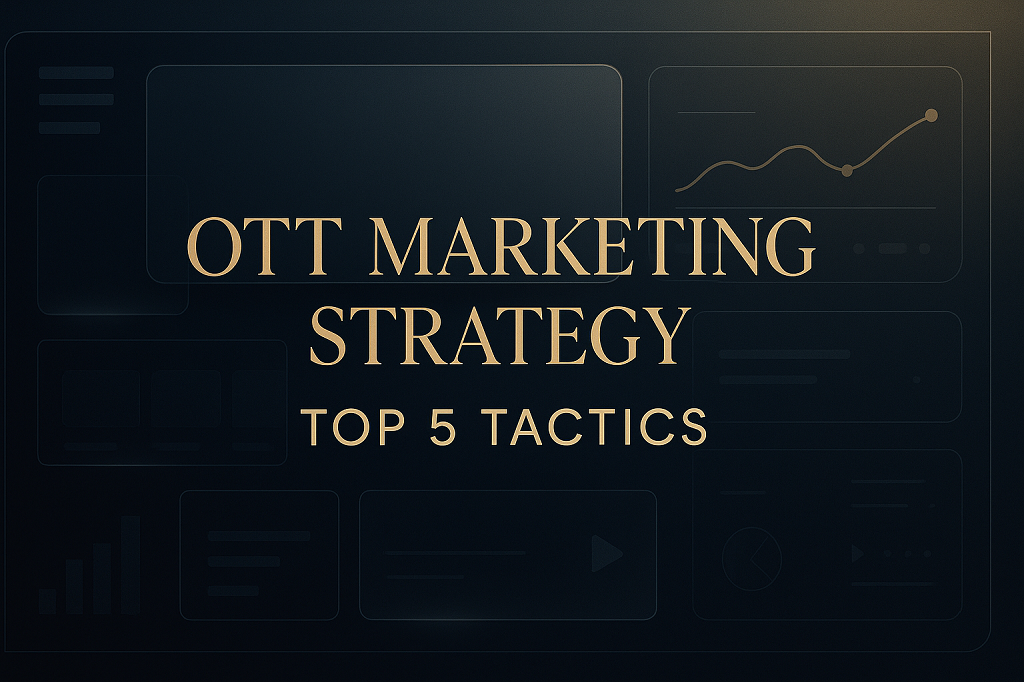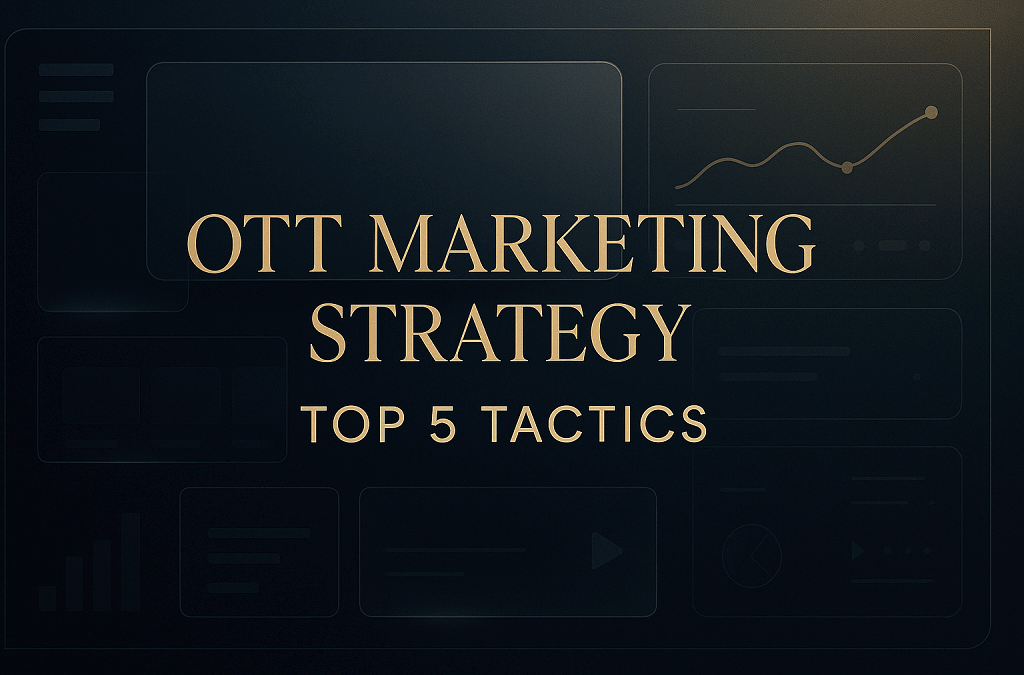
OTT stands for “over-the-top,” the streaming delivery model that skips cable and satellite entirely. Viewers consume it through smart TVs, phones, tablets, or any device with an internet connection. That shift has cracked open new ways for brands to reach audiences, and the competition to master an effective OTT marketing strategy is only heating up.
Audiences are no longer glued to fixed schedules. They binge on Netflix, watch Twitch streams at midnight, or pay for niche platforms that serve specific interests — including adult content and live gaming. The freedom of on-demand access has created an ecosystem where attention is fragmented, but also highly measurable. For businesses, that’s a double-edged sword: huge opportunity, but only if you learn how to target and adapt quickly.
In this article, we’ll break down five proven tactics to win in OTT marketing. You’ll see how to build a strategy that makes sense for your audience, measure campaigns with precision, blend traditional TV with modern targeting, use AI and analytics to refine decisions, and keep viewers engaged with creative formats. Each section will connect theory to real-world examples, showing how OTT has become one of the most powerful arenas for growth across industries.
The Essence of OTT Marketing
For marketers, OTT isn’t just another channel — it’s an entire shift in how people consume media. Instead of passively flipping through cable, viewers are choosing what they want, when they want it, across phones, smart TVs, laptops, and even game consoles. That kind of control changes the playbook. You’re no longer buying a slot in the middle of a sitcom; you’re catching someone mid-binge, on the exact device they use most.
A well-planned OTT strategy takes advantage of this flexibility. You can target a viewer who prefers adult livestreams on a tablet at night, or someone who watches cooking tutorials on their phone during lunch breaks. The reach isn’t just broad — it’s specific, and it’s measurable down to the second. Every play, pause, or skip leaves a data trail.
That precision is why so many industries — entertainment, gaming, and adult — are betting big on OTT. Global spending shows the trend: In 2024, the global over-the-top (OTT) revenue reached over 316 billion U.S. dollars, with the United States accounting for the largest share of that sum. For brands, it’s not hype anymore; it’s a proven marketplace where campaigns can be tested, tracked, and optimized in real time.
Tactic #1 — Build a Focused OTT Strategy

Every strong campaign starts with clarity about who you’re talking to. In OTT, that means looking beyond broad demographics and drilling into behavior. Maybe it’s someone streaming on a phone late at night. Others might binge shows on a smart TV every Sunday. And then there are viewers logging in from a desktop at work. Building personas around these habits is what makes an ott marketing strategy stick.
A good OTT plan respects how scattered viewing has become. People don’t watch on just one screen. They move from mobile to TV apps to laptops without thinking twice. If your message looks sharp on one device but breaks on another, you’re leaking attention. Consistency across formats isn’t optional anymore — it’s survival.
This is where AI-driven personalization comes in. Machine learning tools can:
- Flag viewers at risk of churn before they cancel.
- Suggest the best time and length for certain content.
- Predict which segments are most likely to pay for add-ons or premium access.
Take a niche example: a small fitness OTT app that struggled to keep users after the first free month. By segmenting viewers by workout type, device, and session timing, then tailoring recommendations, they extended retention by more than 25%. The principle is simple: the tighter you draw your audience personas, the easier it is to design campaigns that feel personal instead of generic.
OTT isn’t a volume game — it’s about precision. Brands that map their audience properly, design cross-device consistency, and let AI fine-tune the details set themselves up for growth instead of churn.
Tactic #2 — OTT Performance Marketing That Proves ROI

Talk to any media buyer and you’ll hear the same gripe: too much money wasted on impressions that don’t convert. Ott performance marketing was born to kill that waste. It’s not about vague “awareness.” It’s about paying only when real actions happen — a completed view, a signup, or a paid trial.
Metrics that matter most in this space:
- CPCV (cost per completed view): you’re only charged when someone finishes the ad.
- CPA (cost per acquisition): pay when a new user joins or subscribes.
- Paid trials: track how many free-trial signups actually flip into paying customers.
- LTV-based bidding: spend scaled to the predicted lifetime value of a viewer.
The advantage is clear. Instead of sinking budget into broad campaigns, you tie spend directly to results. Smart marketers don’t just run ads — they treat them like experiments. Creative A goes to one region, Creative B to another, and within a week you know which to kill and which to scale. One adult VOD service cut wasted spend by 35% after splitting campaigns by geography and language, realizing half their clicks from a specific region never converted.
Why brands lean into performance marketing:
- Budget control: no endless burn on empty impressions.
- Speed: results arrive in days, not months.
- Transparency: every view, click, and signup sits in the dashboard.
- Optimization loops: test, learn, adjust, repeat.
- Granularity: segment by device, region, or even time-of-day performance.
- Revenue alignment: campaigns run until ROI turns negative, not until a calendar date hits.
OTT channels give you the freedom to measure, slice, and reallocate on the fly. It’s advertising treated like a science experiment, where every dollar is accountable.
Tactic #3 — Blend with TV Marketing Strategy for Scale
Marketers often think of television and streaming as two separate worlds. The smart move is to link them together. A national TV buy can still build broad awareness, while OTT picks up the job of converting that attention into measurable results. When you tie both into a single OTT marketing strategy, you get the best of reach and precision.
Here’s how the blend works in practice:
- Linear TV flight: runs during prime hours to maximize exposure.
- OTT extension: retargets those same viewers with clickable ads.
- Sign-up funnel: TV sparks interest, OTT drives actions like free trials or subscriptions.
- Frequency capping: stops the same person from being hit with too many impressions.
- Sequencing: shows a teaser first, then a deeper spot, then a call-to-action ad.
A real campaign example: a subscription video brand booked a cable slot during a popular drama to build awareness. At the same time, its OTT ads ran on connected TVs and phones, targeting that exact audience with signup offers. The linear side delivered mass reach; the OTT side tracked conversions down to the device.
This kind of coordination prevents wasted spend and protects brand perception. Instead of hammering people with the same message, you guide them step by step — awareness, engagement, action.
Tactic #4 — Data Targeting + AI Analytics

For decades, TV ads were sold like billboards. You bought a slot, crossed your fingers, and hoped people paid attention. OTT flipped that model. You’re not buying airtime anymore — you’re buying audiences. That shift is what makes the medium so powerful.
Marketers can now carve viewers into precise groups. Instead of “adults 18–49,” you can zero in on:
- Viewers who watch late at night on mobile.
- Regions with higher subscription rates.
- Interest clusters like gaming, fitness, or adult entertainment.
- Recency segments — people who just signed up, or those drifting away.
- Pay propensity groups based on past spending patterns.
The real magic comes when AI starts steering the wheel. Algorithms can swap out creatives automatically, serve the right format at the right time, and even raise a red flag if a campaign suddenly underperforms. Think of it as a safety net that also sharpens your aim.
Here’s how the difference looks side by side:
| Capability | Traditional TV | OTT Marketing |
| Targeting | Broad demos | Behavioral, geo, intent-based |
| Measurement | Panel ratings | Real-time, event-level |
| Creative agility | Fixed ad spots | Dynamic, AI-optimized |
| Optimization speed | Weeks or months | Minutes or hours |
| Conversion tracking | Limited | Full funnel, down to purchase |
When you run an OTT marketing strategy with this kind of targeting, you’re not gambling on exposure. You’re putting messages in front of people who are most likely to act, and you’re adjusting constantly based on proof instead of hunches.
Tactic #5 — Creative That Keeps Viewers Engaged

Targeting and data can get you in front of the right person, but creativity keeps them watching. OTT lets you build formats that go far beyond the static 30-second TV spot. Viewers can click, swipe, or scan in the middle of a show without ever leaving the screen.
Some of the most effective tools right now include:
- Clickable overlays that let people buy or subscribe instantly.
- Shoppable video where a product tag opens a checkout page.
- QR codes that push trial offers straight to a phone.
- Live chat during streams, turning ads into conversations.
Shorter formats also thrive. Six- to fifteen-second teasers grab attention. Mid-roll hooks drop when engagement peaks. End-card offers nudge viewers right before they leave. When you string these together, you guide the audience from curiosity to action without breaking the flow of their viewing.
In the adult space, one creator tested interactive mid-rolls with a simple twist: a clickable prompt for a discounted trial. Trial starts jumped noticeably, proving that interactivity isn’t a gimmick — it’s revenue.
The lesson is simple: creativity isn’t window dressing. In OTT, it’s the lever that turns a passive viewer into an active customer.
Scrile Stream — Customizable Development Service, Not a Platform

Most tools in the streaming world try to lock you into their ecosystem. Scrile Stream takes a different path. It’s not another ready-made platform — it’s a white-label development service that builds your streaming business under your own brand. That means your logo, your domain, your rules.
The toolkit goes deeper than design. Scrile Stream gives you the building blocks to shape how money flows through your service. You decide the mix of monetization:
- Pay-per-view events for exclusive shows or single broadcasts.
- Recurring subscriptions to lock in predictable revenue.
- One-time tips that reward creators directly during streams.
- Virtual gifts to gamify the experience and keep fans engaged.
Payouts follow your schedule, not a vendor’s, so you never wait weeks to see revenue hit your account.
On the content side, the feature set is built to handle demanding cases, from adult streaming to large community hubs. Live chat runs alongside video. Moderation tools keep audiences safe. Admin dashboards track analytics in real time, so you always know what drives engagement and what needs tweaking.
This level of control is what separates a tailored build from generic SaaS. A pre-packaged service can’t offer true ownership. You’re stuck under their branding, revenue cuts, and fixed options. With Scrile Stream, the foundation bends to your needs — whether that’s a niche fan platform or a full-scale media network.
For anyone serious about an OTT marketing strategy, that flexibility matters. Campaigns are more effective when the product itself is designed around your audience. Scrile Stream ensures you’re not just renting space online — you’re running the entire house.
Conclusion
The streaming landscape rewards those who move with intent. A solid OTT marketing strategy doesn’t happen by accident — it’s built from five core moves. First, define who you’re targeting and how they watch. Then, measure everything with performance-driven campaigns. Blend the broad reach of TV with the precision of OTT. Layer on data targeting and AI to sharpen results. Finally, keep viewers hooked with creative formats that make them interact instead of just watch.
Each of these tactics points toward the same truth: campaigns need both precision and flexibility. That’s where custom-built solutions shine. Off-the-shelf platforms can get you started, but they can’t give you ownership or the freedom to build on your own terms.
Scrile Stream makes that possible. It hands you the tools to design a streaming service with your brand, your monetization rules, and your growth plan baked in. If your goal is long-term efficiency and a marketing engine that scales, this is the smarter path.
Ready to take the next step? Talk with the Scrile Stream team today and start shaping an OTT marketing strategy that actually works for your business.
FAQ
What is OTT in marketing?
OTT in marketing refers to delivering ads and content through internet-connected devices, skipping cable and satellite. It allows brands to go direct-to-consumer across phones, smart TVs, and desktops. The benefits are clear: measurable results, granular targeting, and flexibility to adjust campaigns in real time. Instead of paying for vague impressions, marketers track clicks, trials, and purchases. This precision makes OTT an essential part of any modern OTT marketing strategy.
What is the OTT content strategy?
An effective OTT content strategy begins with knowing your audience: who they are, when they watch, and on which devices. From there, you build high-quality content tailored to their habits. User experience matters just as much as production value, so smooth navigation and smart recommendations should be part of the plan. Analytics then guide decisions, showing which content keeps viewers engaged and which formats fall flat.
How to promote an OTT platform?
Promoting an OTT platform takes structured planning. Map out campaigns with clear goals, then identify the right audience segments. Study competitor moves to spot gaps. Choose the platform features that fit your vision, and build a content plan that balances consistency with creative experiments. Don’t ignore SEO or production quality — both drive discovery and retention. Strong promotion aligns with a long-term growth strategy.

